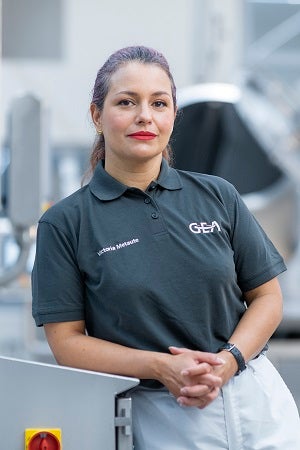
“GEA wants to contribute to food quality and improve yields. We have several solutions for that,” says Willem Poos, Product Group Owner – Marination at GEA Food Solutions.
For Poos, improving the marination and the brining process – which helps customers to add flavour and juiciness into meat products and optimise shelf life while increasing yield – for customers is a significant way to impact quality and yields in the ham and bacon markets. But first, he and his team must extoll the benefits to a side of the meat sector that sometimes be a little “traditional and conservative,” he says. “Sometimes, because some customers have worked in a certain way for 25 years or longer, they think, ‘Why should we change?’ Often they are not always aware of the food hygiene risks for ham and bacon and the prospect of losing yield.”

For Poos and his colleagues, including Victoria Metaute, Food Technologist at GEA, taking the first step towards improving food quality and yields is often the hardest for food producers, but acknowledging how important it is to get marination right at the beginning of the process for ham and bacon products is certainly the most important. “You can take a good raw product, but if you mess up the marination aspect, the product is already ruined. You have to get that first part right,” says Poos.
“The basis for a successful product is about being in control of your processes, says Metaute.
“There’s a lot of impacts that we cannot influence, including the raw product that the customer uses. So, we must assume the customer has a good product to start the process with. Then we try to maintain it as good as it is, or even improve it so that our customer gets the most out of the product,” adds Poos.
Enhancing yield
Frequently, customers are not aware of the yield losses their products are experiencing, says Poos. “Or they simply accept them because they are not aware that they have an influence on future yields in that first step of the process. They first need to understand the process and be able to, judge for themselves. Is old equipment letting them down, for example?”

If, says Metaute, a company has been making ham for many years, but their final product has always been watery on the outside, for example syneresis, that might not seem to be a problem for them. It’s just normal. But in order to understand the status quo, we can start with asking them, ‘Why is this final product like that? And start asking, ‘Can we possibly extend the tumbling process?’ Or can we measure the temperatures and injection levels? Or look at the cooking methodology?’ That is when we start to have a better understanding on their process and limitations. When having a clear picture, it is when we can action tasks with the main goal of having better results; and help them to control the overall processes,” she says.
A good example of the benefits of GEA’s technology, says Poos, pertains to the defrosting of meat. “We have a customer in Chile who only buys frozen meat from mainly the US. Because it is limited available on their home market. But when you defrost meat, a lot of water drips out – that’s the first loss of yield you experience. When they let the meat to defrost for 24-72 hours in cooling chambers a lot of the moisture just ends up on the floor and in the gutter – and it can sometimes be up to a 10% loss of yield. If you’re buying in 100 kilos a product and you can only get to use 90 kilos, that is a massive loss over the course of a year.” This is the reason why they have chosen the GEA defrosting technology, as now their losses of proteins are kept to the minimum, resulting in a process with high control and added value.
Those yield losses, says Metaute, also impact on the capacity of ham and bacon products to shape effectively and stick together. This will most likely also impact later on the slicing process too, where further losses of yield will incur when pork products are not bound correctly and start disintegrating instead of forming the desired sliced portions, “because the bonding and gelling is not strong enough,” she says.
“We have a solution to retain this protein loss so that customers have a ‘fresh-like’ start to the process. Especially for ham production, this is a really good benefit, says Poos. One such product that allows for better defrosting and tempering of meat and poultry products is GEA’s ColdSteam T, which provides faster, safer, more efficient and improves overall yield because the drip is saved containing valuable protein. By industrial defrosting in a sealed environment, using steam under a near vacuum, frozen products can be defrosted quickly and safely, without compromising on product quality and overall yield. The Chilean customer has seen these benefits and has already been investing for many years in this technology, resulting in an installed base of 10 units. And still growing!
The real money-maker
“When you make customers aware of how much protein – the natural binding element in meat – can be lost and how much money you can save, you have their interest. GEA’s machines can pay back the investment spent on them, quite often within one year. It’s a real money-maker,” says Poos.
The team can also show customers how further investment in technology down the process line will also deliver significant value. From having the right brine preparation – GEA ScanBrine brine preparation system offers controlled and efficient mixing of brines and marinades with the flexibility to easily adapt to meet specific application needs – to the right brine injection equipment, cutting-edge tumbling or massaging technology (which optimises product quality and the consistency of the marinating process) and then, after the cooking of the meat is done,
GEA can also help customers improve the meat slicing too. These holistic solutions can inject value throughout the whole process where GEA is focussed on quality and accuracy instead of challenging on what high injection percentage can be injected. We pursue quality before quantity.
So how does the technology work to improve quality? “We qualify the quality parameters required for each process step in the factory, to reduce losses. For us – and the customer – ‘quality’ can refer to food safety, but also to the shelf life of a product or the final appearance. We ask, ‘What does good look like?’ at every step of the process and show how the technology can improve all of those aspects,” says Poos.
Injecting value
Injecting value into the brining process is possible, says Metaute, because of the strict quality control conditions afforded by GEA’s technology. That control ensures for consistent temperatures being maintained as the brine is injected into the ham or bacon products to ensure food safety is strictly adhered to, while the injection quantity, size of the needles and the type of needle being used to ensure the meat products are not damaged during the process and remain as intact as possible, are carefully assessed. “It’s all about how the machine, the quantity of needles, the size of needles, and the temperature control work together for the meat to keep the quantity of brine and its structure, says Metaute.
One such product, the GEA MultiJector 2mm, gives customers the full benefit of GEA’s industry leading marination technology. Precise 2mm brine injection of pork belly and poultry products is made possible through 792 thin needles that allow for a horizontal flow of brine to the product. That means less blockages and outstanding brine distribution thanks to tight needle pattern with an exceptionally high number of injection points. Its unique 2mm OptiFlex material helps prevent bent or broken needles, while no needle marks are left in the meat product after brine injection. This is even improved with the use of MultiShakers. The process of shaking an injected meat gives the advantage of closing the needles holes immediately therefore avoiding the brine to scape, while in the meantime smoothly erasing the needles marks, giving the appearance of an intact product.
“Because our needles are 2mm. it makes it possible to put them in a very close pattern. If you look at every square inch of pork belly for example, you can utilise a good injection pattern. And you don’t have to use that much pressure to disperse the brine into the products. In that way, we have an advantage in that our salt distribution of the brine to the product is optimal. Nobody can do this better than us,” says Poos.
“It’s more even distribution and faster,” adds Metaute.
The machine’s filter technology, which recognises when to keep the needles open so the process can continue, creates more uptime for the customer, says Poos. “If you talk with customers in the injection business, the main concern is always, “How long can I work without needles getting clogged or there being problems with filtration?’’ he says. Due to the effectiveness of the different filters the system, the pollution stays on those and not allowed to enter into the needles system and if there is the need to remove the filters for cleaning, there is the flexibility without the necessity of stopping the injection process.
For a multi-purpose offering for the industrial marination of cooked ham products, the GEA MultiJector brine injection system with 4mm OptiFlex needles features consistent vertical brine distribution throughout the full depth of the product. In addition, its strong and flexible needles can cope with tough, bone in and large pieces without deformation or breakages. The 4mm brine injector guarantees consistent product quality, machine duration and maximum profitability.
For ham products, the GEA MultiCarve is also an efficient addition. An industrial tenderizer equipped with different profile rotating knife rollers, which increases the surface area of meat for pork ham and cooked/sliced poultry products, the MultiCarve delivers efficient tenderising, helps to shorten curing time and contributes to consistent food quality.
Satisfied customers
The feedback from customers to these products is incredibly positive. “Some of our customers have been using our marination line technology since the early beginning:1969. The technology has helps them to grow and maintain their competitive position in the market, and we are still a long-lasting partner on this journey. We feel very proud of their achievements and satisfied that we are part of it. We can beat the competition on many ways,” says Poos.
“Our technologists, such as Victoria Metaute, provides a great resource of knowledge,” he says. “If a customer wants to be helped through the whole process, she goes through every step with them and look for improvements. So, the overall process is enhanced, and she can make a difference compared to a lot of competition who are only focused on one aspect, such as marination, cookers or slicing. We have everything – that is where we make the difference, we have real process knowledge.”
For more information on this topic, please download the whitepaper from GEA Foods below.


